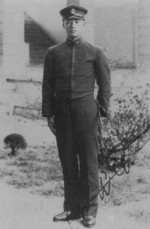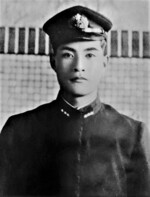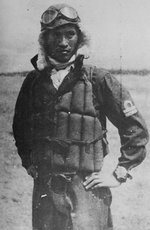Yukio Seki
| Surname | Seki |
| Given Name | Yukio |
| Died | 25 Oct 1944 |
| Country | Japan |
| Category | Military-Air |
| Gender | Male |
Contributor: C. Peter Chen
ww2dbaseYukio Seki was born in Iyo Saijo, Shikoku, Japan. In 1938, he was accepted into both the Navy and the Army's academies, and he opted to join the Navy. He graduated from Eta Jima in Nov 1941. His early career saw him aboard battleship Fuso and seaplane carrier Chitose; aboard the latter he played a very minor role in the Battle of Midway. In 1942, he enrolled in the Naval flying academy in Kasumigaura, Ibaraki, Japan, and then trained as a carrier dive bomber pilot. In Jan 1944, he became an instructor at Kasumigaura. In Sep 1944, he was transferred to Tainan, Taiwan then in Oct 1944 to the 201st Air Group in the Philippines.
ww2dbaseAt Philippines, Vice Admiral Takijiro Onishi authorized the transformation of the occasional suicide fighter attacks by dying pilots into a massed campaign. The first kamikaze mission was called during the Oct 1944 Battle off Samar during the Leyte Campaign. He was approached by Commander Asaichi Tamai, who asked him
ww2dbase"You absolutely must let me do it", he answered after a couple of seconds, and it touched Tamai. However, Seki was later quoted in saying "Japan's future is bleak if it is forced to kill one of its best pilots. I am not going on this mission for the Emperor or for the Empire... I am going because I was ordered to!" On 20 Oct 1944, Seki cut a small strand of his hair and gave it to Tamai to bring home to his parents; it was a tradition of Japanese warriors who wished to send something for their families to remember them by. Several days and several unsuccessful kamikaze missions passed before Seki's Shikishima special attack squadron of Zero fighters found their target. Prior to the attack, some of his comrades noted that Seki would seek all opportunities to drop his bomb before considering a suicide attack. When Chief Warrant Officer Hiroyoshi Nishizawa returned from battle, he reported that Seki's fighter was the first to attack at 1045 (American reports put his attack at 1051), immediately followed by another suicide attack at the same spot. Flames rose 1,000 meters in the air, recalled Nishizawa. Whether Seki actually plunged into the American carrier St. Lo as a kamikaze is still unknown today, but his 250-kilogram bomb undoubtedly played a critical part in the sinking of the American ship.
ww2dbaseSources: the Divine Wind, Wikipedia.
Last Major Revision: Nov 2006
Yukio Seki Interactive Map
Photographs
 |  |  |  |
Yukio Seki Timeline
| 25 Oct 1944 | During the first major special attack conducted by the Japanese Navy, pilot Yukio Seki sank carrier USS St. Lo while another suicide pilot damaged carrier USS Santee. |
Did you enjoy this article or find this article helpful? If so, please consider supporting us on Patreon. Even $1 per month will go a long way! Thank you. Share this article with your friends: Stay updated with WW2DB: |
Visitor Submitted Comments
21 Jan 2012 03:47:33 AM
My goodness Peter, you are doing a marvelous job of this site...good on you!
I would be happy to let you use any of my Aircraft illustrations, gratis, if you wish to.
Kind regards
Mike Dunne
21 Apr 2015 06:15:08 AM
This man was responsible for the death of my uncle Harrell Gargus,a crewmember on the St. Lo.
All visitor submitted comments are opinions of those making the submissions and do not reflect views of WW2DB.
» Philippines Campaign, Phase 1, the Leyte Campaign
- » 1,150 biographies
- » 337 events
- » 43,917 timeline entries
- » 1,241 ships
- » 350 aircraft models
- » 207 vehicle models
- » 373 weapon models
- » 123 historical documents
- » 260 facilities
- » 470 book reviews
- » 28,537 photos
- » 432 maps
Lt. Gen. Lewis B. "Chesty" Puller, at Guadalcanal
Please consider supporting us on Patreon. Even $1 a month will go a long way. Thank you!
Or, please support us by purchasing some WW2DB merchandise at TeeSpring, Thank you!
7 Apr 2011 06:26:37 PM
Fall my Pupils,
My Cherry blossoms.
Just as I will fall
In the service of our land.
Poem/Song by Lieutnant Yukio Seki during WW2